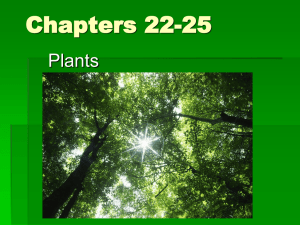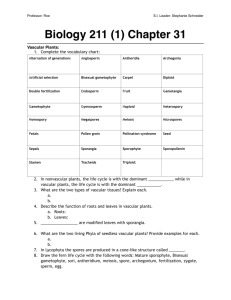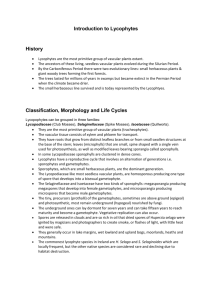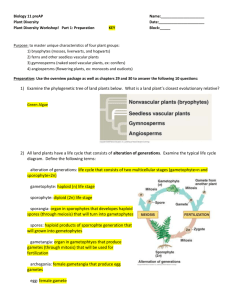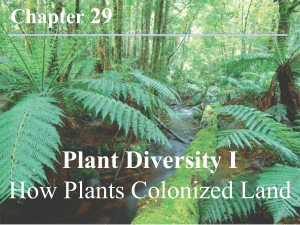Class Notes-10-19-09 Transport in xylem and Phloem Two types of
advertisement
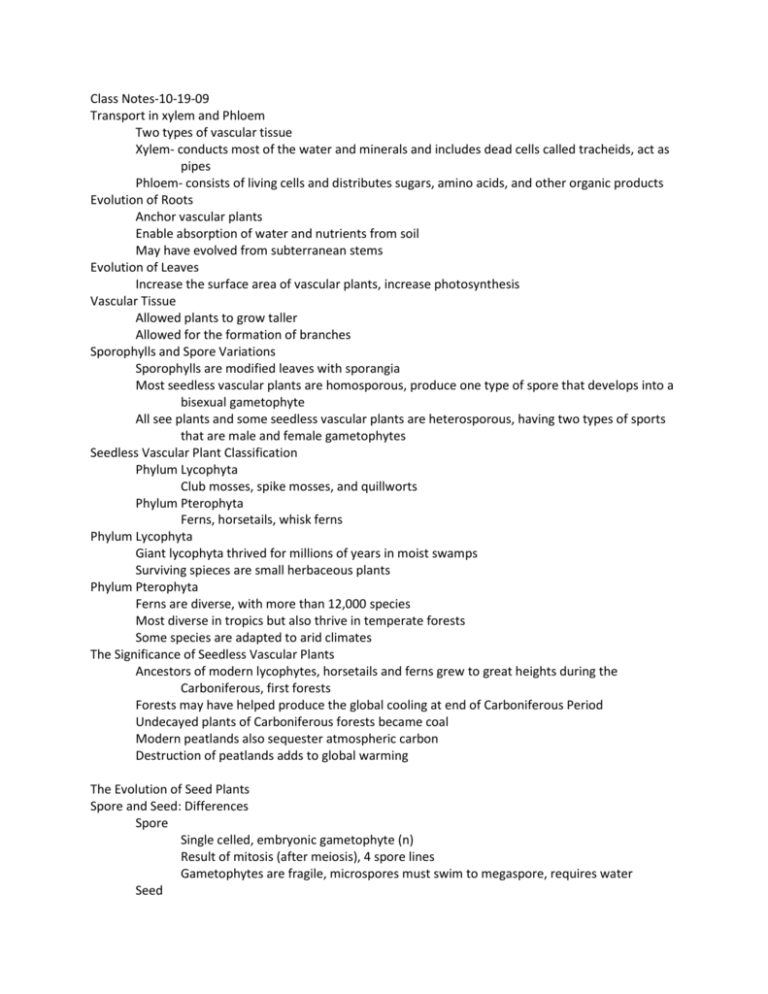
Class Notes-10-19-09 Transport in xylem and Phloem Two types of vascular tissue Xylem- conducts most of the water and minerals and includes dead cells called tracheids, act as pipes Phloem- consists of living cells and distributes sugars, amino acids, and other organic products Evolution of Roots Anchor vascular plants Enable absorption of water and nutrients from soil May have evolved from subterranean stems Evolution of Leaves Increase the surface area of vascular plants, increase photosynthesis Vascular Tissue Allowed plants to grow taller Allowed for the formation of branches Sporophylls and Spore Variations Sporophylls are modified leaves with sporangia Most seedless vascular plants are homosporous, produce one type of spore that develops into a bisexual gametophyte All see plants and some seedless vascular plants are heterosporous, having two types of sports that are male and female gametophytes Seedless Vascular Plant Classification Phylum Lycophyta Club mosses, spike mosses, and quillworts Phylum Pterophyta Ferns, horsetails, whisk ferns Phylum Lycophyta Giant lycophyta thrived for millions of years in moist swamps Surviving spieces are small herbaceous plants Phylum Pterophyta Ferns are diverse, with more than 12,000 species Most diverse in tropics but also thrive in temperate forests Some species are adapted to arid climates The Significance of Seedless Vascular Plants Ancestors of modern lycophytes, horsetails and ferns grew to great heights during the Carboniferous, first forests Forests may have helped produce the global cooling at end of Carboniferous Period Undecayed plants of Carboniferous forests became coal Modern peatlands also sequester atmospheric carbon Destruction of peatlands adds to global warming The Evolution of Seed Plants Spore and Seed: Differences Spore Single celled, embryonic gametophyte (n) Result of mitosis (after meiosis), 4 spore lines Gametophytes are fragile, microspores must swim to megaspore, requires water Seed Embryonic sporophyte, multicellular, differentiated Result of fertilization (2n), each is unique Sporophytes often more resistant to desiccation Seed Plant Modification Dominant sporophyte generation Reduction of gametophytes to single cells Gametophytes develop within the walls of spores retained within parent sporophyte Gametophyte is protected from desiccation Drawback- microspore (pollen) must have a vector Heterospory Produce both megaspore and microspore on same plant Megaspores give rise to female gametophyte (ovule) Ovule consists of megasporangium, megaspore, protective integuments Micropsores give rise to male gametophytes (pollen) Microspores develop into pollen grains Pollination Transfer of pollen to ovules Can be dispersed by air or animals, eliminate water requirement Upon germination, it grows a pollen tube with two sperm nuclei Evolutionary Advantage of Seeds Seed develops from the whole ovule Seed is a sporophyte embryo and food supply in protective coat Gymnosperms “Naked” seeds, born in cones Four Phyla: Cycadophyta- cycads or tree ferns Gingkophyta- one living species: gingko biloba Gnetophyta- specialized for desert living Coniferophyta- conifers: pine, firs, redwood Gymnosperm Evolution Progymnosperms in Devnian Period True gymnosperms in early carboniferous Dominated Mesozoic terrestrial ecosystems Life Cycle of a Pine- Key Features Dominance of sporophyte generation Seeds develop from fertilized ovules Transfer of sperm to ovules by pollen Angiosperms- flowers and fruits Have reproductive structures- flowers and fruits A single phylum- anthophyta The most widespread and diverse of all plants Flowers Structures specialized for sexual reproduction Has up to 4 types of modified leaves Sepals (calyx)- encloses the flower Petals (corolla)- brightly colored and attract pollinators Stamens (androecium)- produce pollen Carpels (gynoecium)- produce ovules Fruits A fruit consists of a mature ovary but can also include other flower parts Protect seeds and aids in dispersal Mature fruits can be either fleshy or dry Dispersal Various fruits adaptations help disperse seeds Seeds can be carried by wind, water, or animals to new locations The Angiosperm Life Cycle Double Fertilization- two sperm nuclei One sperm fertilizes the egg (2n) Other combines with two nuclei to produce endosperm (3n) Endosperm nourishes the developing embryo Angiosperm Evolution Originated at least 140 million years ago During the Cretaceous, major branches diverged Primitive fossils of angiosperms display derived and primitive traits Monocots vs Dicots One cotyledon two cotyledons Parallel veins netted veins Scattered vascular bundles vascular bundles in rings Fibrous root structure branching roots with taproot Flower parts are 3s flower parts in 4s or 5s Pollen with 1 pore pollen with 3 pores
